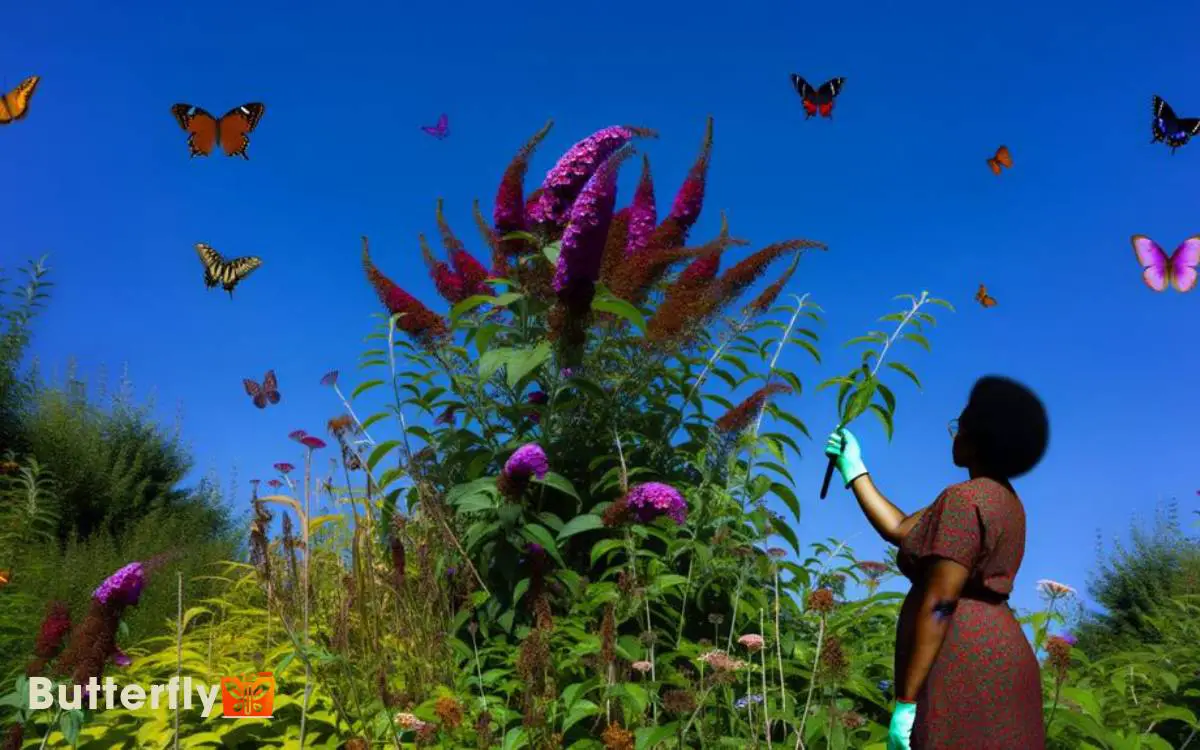Do You Deadhead a Butterfly Bush? Yes!
Yes, you should deadhead a butterfly bush to extend its blooming period and improve overall health.
Use sharp, sterilized pruning shears to snip off spent blooms just above a healthy leaf node. Regular deadheading prevents seed formation, redirects energy towards new flowers, and keeps the plant tidy.
Conduct this practice throughout the blooming season for best results. Deadheading also reduces the likelihood of disease and enhances the bush’s aesthetic appeal.
For thorough care and maximizing blooms, consider additional pruning methods and proper seasonal maintenance. There are more detailed practices to explore for the best results.

Key Takeaways
Understanding Butterfly Bushes
Butterfly bushes (Buddleja spp.) are deciduous shrubs known for their fast growth and vibrant, fragrant flowers that attract pollinators like butterflies and bees.
You’ll find these bushes thrive best in well-drained soil and full sunlight, achieving peak growth when you water them regularly during dry periods. Pruning is vital; it promotes vigorous blooming and controls plant size.
These shrubs are hardy in USDA zones 5-9, tolerating a range of temperatures. Their inflorescences, composed of numerous small flowers, bloom from summer to early fall.
Regular monitoring for pests like spider mites and aphids is important, as is maintaining soil pH between 6.0 and 7.5. By understanding these aspects, you’ll ensure your butterfly bush remains healthy and visually appealing.
The Purpose of Deadheading
Deadheading serves to extend the blooming period and redirect the plant’s energy towards producing new flowers rather than seed development. By removing spent blooms, you enhance the overall vitality of your butterfly bush.
Here are four primary benefits:
- Prolonged Blooming: Regular deadheading stimulates continued floral production, ensuring a longer display of vibrant flowers.
- Resource Allocation: The plant reallocates nutrients and energy from seed production to new growth, enhancing overall health.
- Disease Prevention: Removing spent flowers can reduce the risk of fungal infections and other diseases associated with decay.
- Aesthetic Appeal: Consistently deadheading keeps your butterfly bush looking tidy and attractive, contributing to the garden’s visual charm.
Incorporating these practices guarantees your butterfly bush remains robust and floriferous throughout the growing season. Regular pruning encourages new growth and helps maintain the plant’s shape, ensuring a continuous display of vibrant blooms. Additionally, providing well-draining soil and adequate sunlight further supports its health and longevity. If you’re wondering, do deer eat butterfly bushes, rest assured that these plants are generally deer-resistant, making them a low-maintenance choice for gardens in areas with frequent wildlife.
When to Deadhead
You’ll need to deadhead your butterfly bush regularly throughout the blooming season to promote continuous flowering. The best timeframe is immediately after the flowers start to fade, ensuring energy is redirected to new growth.
Prioritize seasonal timing; early spring and late summer are critical periods for deadheading to maximize plant health and flower production.
Optimal Deadheading Timeframe
The best time to deadhead your butterfly bush is immediately after the flowers start to fade and wilt. This timing encourages continuous blooming and prevents the plant from expending energy on seed production.
Here’s a precise guide to follow:
- Monitor Flower Health: Check your butterfly bush regularly for any signs of fading or wilting flowers.
- Use Clean Tools: Always use sterilized pruning shears to avoid transmitting diseases.
- Cut at the Right Spot: Make your cuts just above the nearest set of leaves or lateral buds to promote new growth.
- Dispose Properly: Remove the deadheaded flowers from your garden to maintain cleanliness and prevent disease spread.
Implementing these steps will help your butterfly bush remain vibrant and healthy.
Seasonal Timing Importance
To maximize your butterfly bush’s blooming potential, you should consider the seasonal timing of your deadheading efforts. In essence, initiate deadheading in late spring when the first flowers begin to fade. This encourages additional blooming cycles throughout the summer.
Continue deadheading regularly through early autumn, as removing spent blooms prevents seed formation and directs energy towards new growth. Pay close attention to your local climate; regions with milder winters may allow for extended deadheading periods.
Avoid late-season deadheading in areas prone to early frost, as it can stimulate tender growth vulnerable to cold damage. Ultimately, your goal is to balance flower production and plant health, ensuring your butterfly bush thrives across multiple blooming phases.
Tools for Deadheading
You’ll need sharp pruning shears or scissors for deadheading your butterfly bush. Make sure your tools are clean and sterile to prevent disease transmission.
Regularly maintain your tools by sharpening blades and lubricating moving parts for best performance.
Essential Deadheading Tools
When deadheading a butterfly bush, you need sharp pruning shears to guarantee clean cuts and prevent damage to the plant. Utilizing the correct tools secures efficiency and promotes healthy regrowth.
Here’s a concise list of essential deadheading tools:
- Pruning Shears: Essential for precise cuts, reducing the risk of disease transmission.
- Bypass Loppers: Ideal for thicker stems, providing leverage and accuracy.
- Gloves: Protect your hands from thorns and rough branches.
- Disinfectant: Prevents the spread of pathogens between cuts.
Each tool has a specific function, contributing to the overall health and aesthetics of your butterfly bush. Accurate tool selection and usage are crucial for successful deadheading, fostering robust and vibrant blooms.
Proper Tool Maintenance
Maintaining your deadheading tools guarantees they perform at their best and last longer, directly impacting the health and appearance of your butterfly bush. Start by cleaning your pruners and shears after each use to prevent rust and pathogen transfer.
Use a brush to remove plant residue, then sterilize with a 10% bleach solution. Sharpen blades regularly using a whetstone or sharpening tool to ensure precise cuts, which minimize plant stress and disease entry points.
Lubricate pivot points with machine oil to maintain smooth operation. Store tools in a dry, cool place to avoid moisture damage. Regular maintenance not only extends tool lifespan but also maintains your butterfly bush remains vibrant and healthy through effective deadheading.
How to Deadhead
To deadhead a butterfly bush, use sharp, sterilized pruning shears to remove spent blooms just above the nearest set of healthy leaves. This technique prevents seed formation and redirects the plant’s energy toward new growth.
Follow these steps:
- Identify Spent Blooms: Look for faded, brown, or wilted flower clusters.
- Position Shears: Place the blades just above the first pair of healthy leaves below the spent bloom.
- Cut Cleanly: Make a precise, angled cut to promote water runoff and reduce disease risk.
- Dispose of Debris: Collect and dispose of the removed blooms to prevent fungal issues.
Benefits of Deadheading
Removing spent blooms isn’t only a necessary maintenance task but also brings several key benefits to your butterfly bush. Deadheading stimulates the plant to produce new flowers, enhancing its overall aesthetic appeal.
By removing old flowers, you prevent seed formation, allowing the butterfly bush to redirect energy towards growth and flowering rather than seed production.
This practice also minimizes the risk of diseases, as decaying blooms can harbor pathogens. Additionally, deadheading improves air circulation around the plant, reducing humidity levels and deterring fungal infections.
Regular deadheading encourages a prolonged blooming period, ensuring your butterfly bush remains vibrant and attractive throughout the season.
Implementing this technique promotes a healthier, more vigorous plant, maximizing its ornamental and ecological value in your garden.
Common Mistakes
One common mistake gardeners make when deadheading a butterfly bush is cutting too far down the stem, which can harm the plant’s growth and flowering potential.
To avoid such issues, follow these guidelines:
- Cut Above the Leaf Node: Make sure you make your cut just above a leaf node to promote healthy regrowth.
- Avoid Cutting During Dormancy: Deadheading during dormancy can stress the plant; wait until the growing season.
- Sanitize Your Tools: Always sterilize your pruning shears to prevent the spread of diseases.
- Don’t Overdo It: Excessive deadheading can deplete the plant’s energy reserves, impacting its overall health.
Alternative Pruning Methods
You can enhance your butterfly bush’s health by exploring light pruning techniques and understanding seasonal pruning tips.
Light pruning involves removing small amounts of growth to shape the plant, while seasonal pruning guarantees you trim at best times for plant well-being.
Additionally, strategic pruning can encourage new growth and boost flowering potential.
Light Pruning Techniques
Strategically employing light pruning techniques can enhance the overall health and blooming potential of your butterfly bush. Light pruning involves removing dead or damaged branches, which can reduce disease risk and improve airflow.
Here’s a practical guide:
- Deadheading: Snip off spent blooms just above the nearest leaf node to encourage new flower growth.
- Thinning: Trim back overcrowded stems to the base to allow sunlight to penetrate and air to circulate.
- Tip Pruning: Cut 1-2 inches off the tips of young shoots to promote bushier growth.
- Sanitizing Tools: Always clean your pruning shears with a 10% bleach solution to prevent disease spread.
These techniques not only maintain plant vigor but also maximize the aesthetic appeal of your butterfly bush.
Seasonal Pruning Tips
While light pruning techniques are essential for maintaining plant health, seasonal pruning can further optimize the growth and blooming cycles of your butterfly bush. Conduct heavy pruning in late winter or early spring before new growth begins.
Remove deadwood and cut back the previous year’s growth to 12-24 inches from the ground. This practice, known as hard pruning, encourages robust new shoots and prevents legginess.
In contrast, summer pruning involves trimming spent flowers to enhance blooming. Target stems above a pair of healthy buds, ensuring cuts are clean and at a 45-degree angle. Disinfect pruning tools to prevent disease transmission.
Encouraging New Growth
To promote new growth in your butterfly bush, consider implementing alternative pruning methods such as rejuvenation pruning and selective thinning.
Rejuvenation pruning involves cutting back the entire plant to about 12 inches above the ground. This stimulates new, vigorous growth from the base.
Selective thinning, on the other hand, targets specific branches to improve air circulation and light penetration.
Here are four key steps:
- Rejuvenation Pruning: Cut back all stems to 12 inches above ground in late winter.
- Selective Thinning: Remove older, woody stems at the base to promote new shoots.
- Timing: Conduct pruning in late winter or early spring before new growth begins.
- Sanitization: Clean tools with alcohol to prevent disease transmission.
These methods promote a healthier, more productive butterfly bush.
Seasonal Care Tips
Maintaining consistent seasonal care, including proper watering, mulching, and pest management, guarantees your butterfly bush remains healthy and vibrant year-round.
During spring, make sure the soil remains moist but not waterlogged, as excess moisture can cause root rot. Apply a 2-3 inch layer of organic mulch to retain soil moisture and regulate temperature.
In summer, deep watering once a week suffices, especially during dry spells. Monitor for pests like aphids and spider mites, using insecticidal soap if necessary.
Fall care involves reducing watering and applying a slow-release fertilizer to strengthen roots for winter.
Encouraging More Blooms
Pruning spent flowers, or deadheading, can greatly enhance the butterfly bush’s blooming potential. By removing faded blooms, you encourage the plant to produce new flowers instead of expending energy on seed production.
Here’s how you can maximize those lovely blossoms:
- Timing: Deadhead regularly throughout the blooming season, ideally once a week.
- Tools: Use sharp, clean pruning shears to make precise cuts, reducing the risk of disease.
- Technique: Cut just above a leaf node or lateral bud to stimulate new growth.
- Observation: Monitor the plant for signs of stress or disease, addressing issues promptly to maintain health.
Conclusion
By now, you understand the importance of deadheading your butterfly bush. It’s a simple task that encourages vibrant blooms and maintains plant health.
So, why not grab your pruning shears and give it a try? Remember to use sharp, clean tools and cut just above a set of leaves.
With regular maintenance, your butterfly bush will thrive, attracting pollinators and adding beauty to your garden.
Are you ready to see those stunning blossoms flourish?






